Social media has a huge impact in most of our lives. When we get a spare moment, it feels normal, almost instinctive, to browse Facebook or Instagram, or find a quick video to watch on YouTube. But what happens when we place too much weight on what we’re seeing online?
This is a particular concern for children, with experts suggesting (1) social media is causing kids to have lower self-esteem and greater levels of anxiety than ever before. In this guide, we’ll address the issue of teen mental health, assessing their reliance on social channels, how it impacts their day-to-day lives and the potential dangers it poses.
We’ll also take a more positive approach – discussing how teens can use social media more mindfully and look after themselves both online and off.
The rise of social media
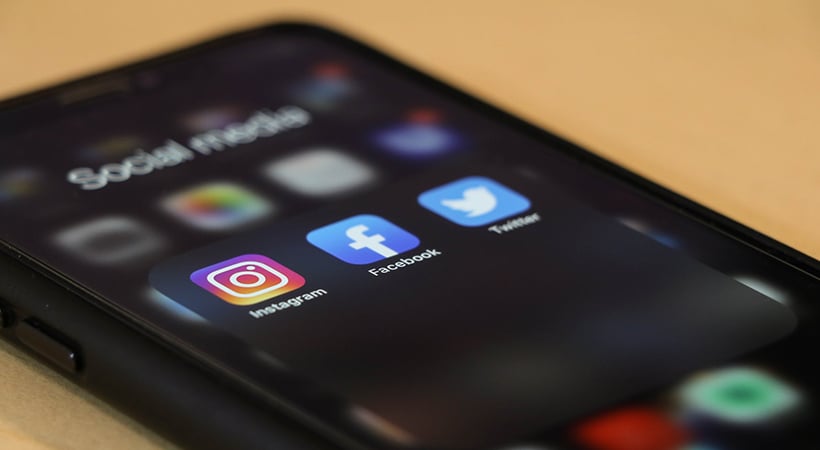
It’s difficult to imagine a world without social media. How many of us check our notifications as soon as we wake up? Or take a photo with the sole intention of posting it online? But it’s a relatively recent addition to our lives.
A brief history
The first platform we’d recognise as a social media network was called Six Degrees. It launched in 1997, and users could create a profile and befriend other users.
MySpace was created in 2003 and had 25 million users by the time it was sold in 2005. Although MySpace is often seen as a precursor to Facebook Facebook’s first iteration (Facemash) was launched in 2003. Since then, Facebook has continued to grow and is the 7th most popular website in the global market (2), as of 2021.
Other social media platforms with specific niches began to emerge in the 2000s, such as microblogging (Twitter, originally known as “twttr”, with posts limited to 140 characters), business networking (LinkedIn), video sharing (YouTube), and photo sharing (Photobucket and Flickr).
The photo and video-sharing app Instagram launched in 2010. It was made especially to showcase photos taken on mobile phones, with hashtags and locations allowing other users to find them.
Digital pinboard site Pinterest soon followed, with arts and crafts and interiors being particularly popular categories.
Snapchat was founded in 2011, allowing users to share photos and videos that disappeared after 24 hours. It attracted a younger audience, many of whom saw it as an escape from parents who were signing up to Facebook.
Although it was created in 2019, TikTok gained mainstream popularity in 2020, as everyone searched for something to alleviate the boredom caused by lockdown during the COVID-19 pandemic. Users share creative 15-second video clips, which are often set to music. It’s reminiscent of the now-defunct platform Vine (3), where users shared six-second clips.
Research published at the start of 2021 shows YouTube is the platform most used by young people (4) aged 15-25 in the UK.
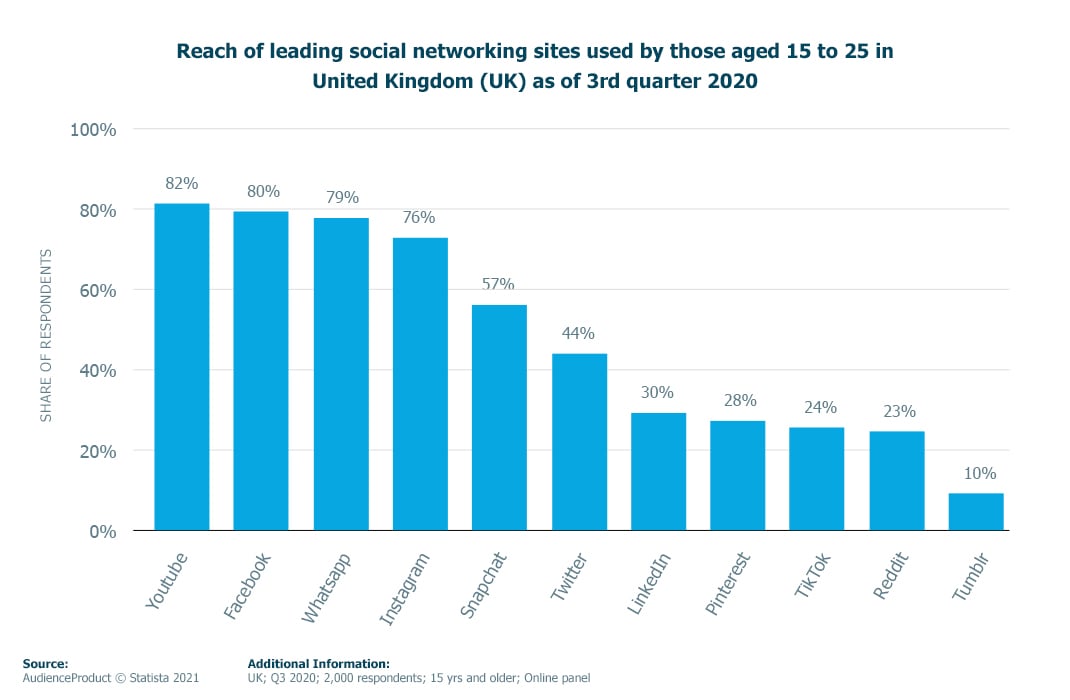
This sets them apart from the UK population in general – according to YouGov’s data (5), the most popular platform is Facebook. Older teens are also more likely to use the internet for social media than other demographics. 91% of them do so (6), compared to 51% of 55-64 year-olds and 23% of people aged 65 and over.
As for younger teens, Ofcom’s Media Use and Attitudes report (7) shows YouTube is also popular with them, with children aged 5-15 more likely to choose it over streaming services or TV channels.
According to the report, the top social media platforms for this age group are WhatsApp, Facebook, Snapchat and Instagram. However, 13% of 12-15 year-olds also use TikTok, and 5% use the gaming platform Twitch.
How using social media can affect teens
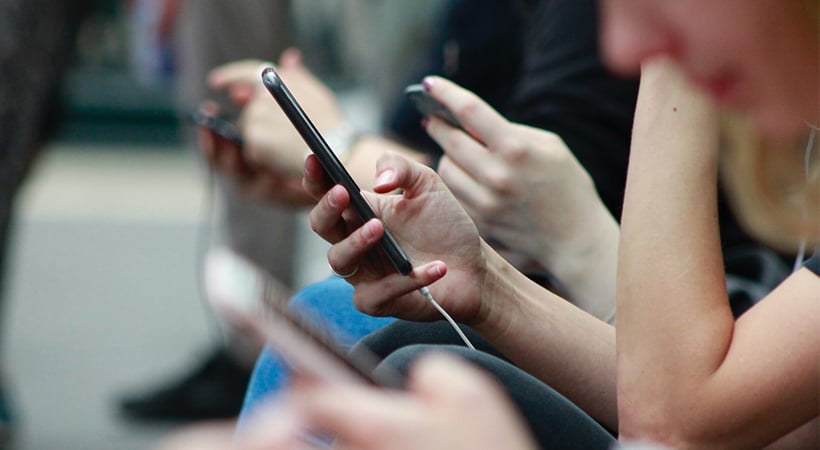
A big part of being human (8) is wanting to be accepted and supported by others. Metrics on social media such as likes and comments can feed into this. The visual nature of some platforms can also lead to comparison, affecting teens in a number of ways. Peer relationships play an important part in adolescent social development (9), with studies showing that teens who are well-liked have higher levels of empathy and are more cooperative.
Mental health
Mental health encompasses our emotional, psychological and social wellbeing: how we feel, how we think, and how we act. Good mental health allows us to be productive, realise our potential, contribute to our communities, look out for our loved ones, and cope with any stress life throws our way.
Sadly, mental health problems appear to be increasing amongst most age groups, including children and teenagers. Research conducted in July 2020 found that the proportion of young people aged 5 to 16 experiencing a probable mental health disorder was 1 in 6 (10), up from 1 in 9 in 2017. 50% of all mental health problems (11) start by the age of 14.
| Group | % experiencing a probable mental disorder in 2017 | % experiencing a probable mental disorder in 2020 |
|---|---|---|
| Boys aged 5 to 16 | 11.4% | 16.7% |
| Girls aged 5 to 16 | 10.3% | 15.2% |
Government research (12) divides children’s and young people’s wellbeing into two categories:
- Subjective wellbeing – how well they think their life is going
- Psychological wellbeing – an objective look at their self-reported feelings and ways of thinking
Their 2020 State of the Nation report found that children and young people’s subjective wellbeing, and some measures of their psychological wellbeing, had decreased compared to previous years.
Anxious feelings amongst 16-24-year-olds notably increased. They were also higher amongst respondents who had special educational needs or a disability, were from a disadvantaged family background, or were from Black, Asian and Minority Ethnic backgrounds.
The coronavirus pandemic may well have affected these results. The Children’s Society’s Life On Hold report (13) surveyed children and teenagers aged 10 to 17 between April and June 2020, when lockdown restrictions were at their most strict. The life satisfaction score was an average of 7.2 out of 10, which was lower than previous years.
It’s difficult to pinpoint how exactly social media contributes towards lower mental wellbeing and mental health conditions. A systematic study from 2020 (14) found multiple theories:
- People who spend more time sitting down have less time to spend with others in person. Interacting face-to-face can reduce the chance of developing a mental health disorder.
- The way we use social media affects how we view, maintain and interact with our social network, which affects our mental health in turn.
- Prolonged use of social media may be linked to symptoms of conditions like depression, anxiety and stress.
- Social media can create pressure for us to be the stereotype we think others want to see.
Although further research needs to be done, it’s clear there’s a correlation between social media use and mental health.
Body image
Body image is how someone thinks and feels about themselves physically. It’s influenced by a lot of things, from how we are brought up to the images we are exposed to – including those on social media. What started as a place to share pictures quickly became a breeding ground for comparison, complicated by the editing tools now available to users.
It’s human nature to compare ourselves to others. But social media gives us more chances to do so. And if you’re already feeling low or vulnerable, it’s easy to forget that not everything on social media is what it seems.
Teenagers in particular will spend a lot of time deciding how they want to present themselves on their social media accounts, well aware their classmates will see anything they share. Coupled with comparison, this scrutiny can lead to body image issues. As a parent you might want to read up on how to talk about body image and self esteem (15).
Research by the Royal Society for Public Health found that 9 in 10 teenage girls said they were unhappy with their body (16). Another survey by the Mental Health Foundation found 25% of boys said their body image worried them (17) “often” or “always”.
Instagram was ranked as the most negative social media platform for wellbeing (18) (including body image) when 14-24 year-olds were asked to score them. This is understandable, given how Instagram is based around visual content like photos and videos.
Filters
On the surface, filters are simple – a fun way to change the aesthetic of a photo, as with Instagram’s preset edits, or add a comic element (who can forget Snapchat’s face swapping filter?)
But filters can also smooth out skin and remove so-called imperfections, tempting teens and adults alike to present flawless versions of themselves in their social media posts. We know that in real life people have uneven skin tone, redness, acne and the like, but when everyone’s photos hide this, it’s easy to feel anxious or alone if your skin isn’t clear. Teens may also use filters as an example of how they ‘could’ look, but this curiosity can quickly make way for feelings of inadequacy, as the edits are often unrealistic.
Photoshop
Photoshop and other photo editing software allows users to make changes to their pictures. While some programs, including Photoshop, have broader uses and are popular in a number of industries, others are more specifically geared towards social media. Free tools like Facetune don’t require editing skills, with auto settings making you skinnier, more tanned, bright-eyed and clear-skinned. It’s ridiculously easy for users, including teens, to drastically change the way they appear in photos.
However, the temptation to create an idealised version of your body can cause unrealistic expectations of how you should look (19). In more severe cases, this can contribute towards mental health conditions such as disordered eating and anxiety.
“People end up creating unrealistic ideals for themselves based on what they see,” confirms Neha Chaudhary, MD, a child and adolescent psychiatrist at Massachusetts General Hospital and Harvard Medical School. They then “feel distressed when they aren’t able to meet those ideas or self-expectations.”
Cyberbullying
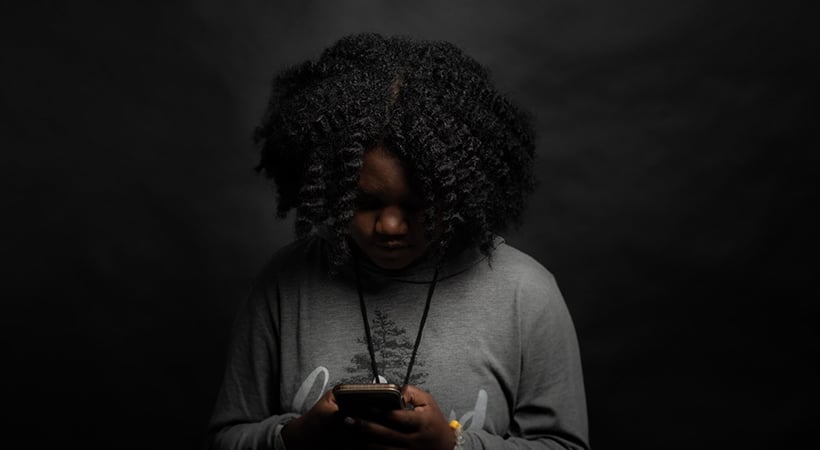
There is no legal definition of bullying, although in simple terms it is behaviour that hurts someone else.
Research from 2020 shows that 19% of children (20) between the ages of 10 and 15 in England and Wales experienced at least one type of online bullying. Being called names, sworn at or insulted, and having nasty messages about them sent to them were the two most common types.
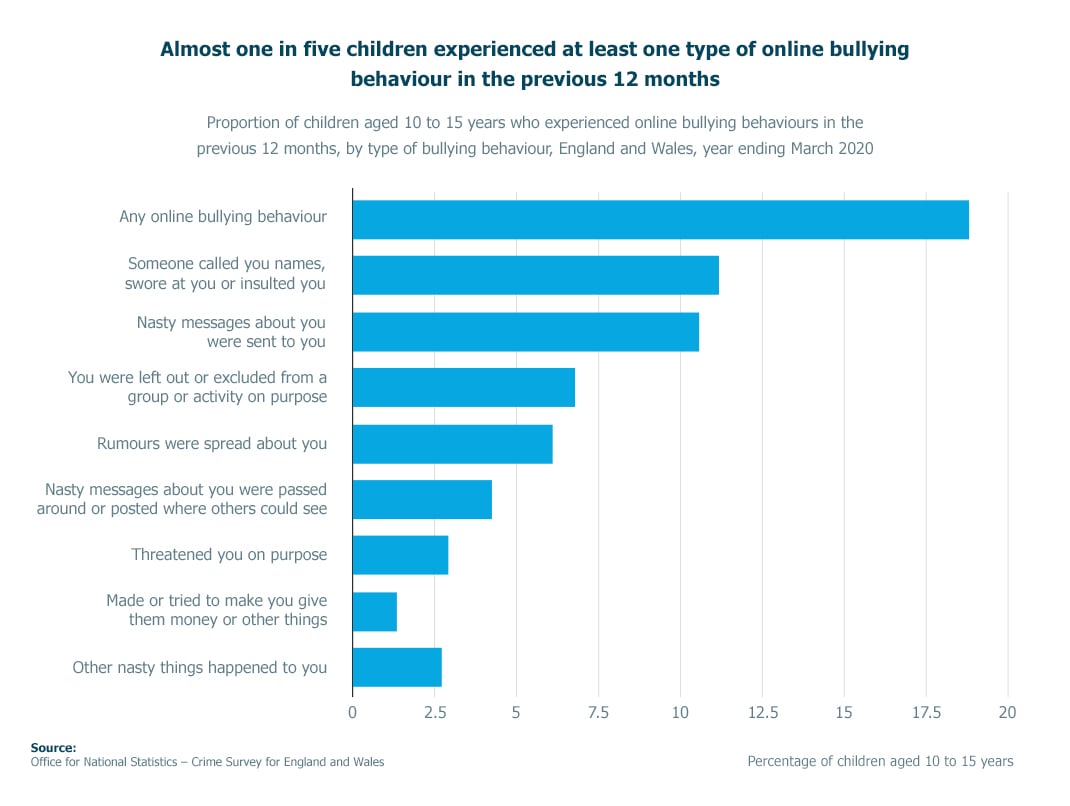
Being behind a screen provides extra separation from the people you’re talking to. In some cases, social media users then feel they can make comments they wouldn’t say face-to-face. It’s also more difficult to interpret nuance over messages and social media posts than it is in person, creating more opportunities for misunderstandings.
“Greater use of smartphones, social media and networking applications means online bullying can follow a child anywhere they go,” says Sophie Sanders from the Office for National Statistics Centre for Crime and Justice. “Children’s isolation at home and increased time spent on the internet is likely to have had a substantial impact on the split between real world and cyberbullying.”
In-person social skills
Even before the pandemic, social media and increased screen time in general meant teens were spending less time with others. It can be easier to spend time online at all times of day than it is to make plans and leave the house.
Add in multiple lockdowns and school closures, and the opportunity for in-person interactions decreased significantly. This can be a problem for young people who are developing important social skills.
Humans are social animals by nature. We need to be around each other as we grow up in order to learn social cues like body language, facial expressions, and verbal reactions. Knowledge of these cues helps us in situations we’ll encounter later in life, for example during employment or other everyday interactions. Spending too much time behind a screen risks teens finding this more difficult.
Mindful social media use and self-care

It is possible for teens to enjoy using social media in a healthy and mindful way, so they don’t get consumed by it.
Setting boundaries
Having boundaries around your teenager’s social media use is a way to make their time online safer and more considered. Psychologist Dana Gionta, Ph.D, recommends taking the following steps (21):
- Ask them to think about why they use social media. Is it to stay in touch with friends? Who would they be comfortable sharing information with?
- Give them time limits. We’ve all picked up our phone to have a quick scroll and spent longer on there than we intended. But this time can quickly add up. Encourage your teen to block out time each day to use social media, so they can stay up-to-date but not overwhelmed.
- They can ask for clarification. It’s more difficult to get your message across in writing than it is in person. Asking for clarification stops awkward misunderstandings, so ensure they feel comfortable doing so. This will help them communicate later in life too.
- Let them know they can be honest with you. They are more likely to come to you if they feel supported. If someone on social media makes your teen feel uncomfortable or upset, you can deal with it together. Some situations can be resolved with a calm, private conversation – the other person may not realise how they’ve come across. However, if their words and actions are inappropriate, let your teen know it’s okay to report the behaviour. They could also seek help from another trusted adult, like a school counsellor.
- Remind them it’s okay to say no. They don’t have to accept every friend request if they don’t want to. They don’t need to have all their notifications switched on. They don’t have to have the volume up on their phone if they find it distracting.
Self-care
Self-care has become something of a buzzword. According to Google Trends, interest in the topic has increased significantly over the last five years.

But strip away the noise and you’ll find it’s an important part of life, for people of all ages. Self-care means looking after yourself in a holistic way, taking care of your health so you can live life to the fullest and help the people around you.
It’s not selfish – it’s essential. Here’s how you can help your teenager establish good self-care habits.
Mental health
Looking after mental health is just as important as looking after physical health. It can help us express our feelings, improve our confidence, maintain good relationships with others, and enjoy life. It also makes us more resilient when we encounter stressful situations or must deal with change. No one can be happy all the time, but you can help your teenager learn to look after themselves through difficult times.
They might confide in you, in a friend, or in another family member. Whoever they choose to speak to, if they verbalise their feelings it can help clarify them, and will often take a weight off their shoulders.
This is easier said than done sometimes! But everyone needs time out, so let your teen know it’s okay to take a break. They might read, watch a film, listen to music or chat to friends. Some people find creative activities like painting or dancing relaxing too.
Learning new things can boost confidence and they may even discover a new hobby.
Everyone deserves support. It’s not always easy to reach out, but there are people and places you and your teenager can turn to for help with their mental health:
- Their school may have a counselling service, or they could speak to a teacher they trust.
- Local charities may have services tailored especially to young people.
- Helplines and text services (22) are available if they don’t want to speak to someone face-to-face.
- Their GP can give you both information and refer them to specialist services like counselling. They can also prescribe medication if they need it.
Although looking after our bodies has physical benefits, it can also improve our mood and energy levels, which are both essential for good mental health.
-
Nutrition. A balanced diet helps us maintain good health and take in all the vitamins and nutrients we need, reaping plenty of benefits inside and out. The NHS recommends (23):
- Eating at least five portions of fruit and veg a day
- Eating high-fibre carbohydrates like brown rice, wholegrain pasta, wholemeal bread and potatoes
- Eating protein sources such as meat, fish, eggs, beans and pulses
- Including a little dairy (or fortified dairy alternatives) in our diets
- Including healthy fats, such as nut butters and avocado, in our diets
- Drinking a minimum of six-to-eight glasses of water per day (more if exercising)
- Consuming sugar, salt and saturated fat in moderation
-
Exercise. Exercise is a great way of getting away from screens and boosting confidence. Teenagers need to do two types of exercise each week: aerobic exercise which raises the heart rate, and strengthening exercises to develop muscles and bones. They are more likely to stick to something they enjoy.
- Examples of aerobic exercise include walking; cycling; rollerblading and skateboarding.
- Examples of strengthening exercises include climbing; team sports like football, netball and hockey; dance; gymnastics; aerobics; running; martial arts; racket sports; resistance exercises (either with equipment or using your own bodyweight).
They should aim for an average of an hour of exercise most days of the week.
-
Sleep. The NHS recommends 8-10 hours of sleep per night (24) for teenagers. They can create good conditions for sleep by:
- Avoiding screens at least an hour before bed
- Dimming the lights in the evening, which will signal to their brain that it’s time to rest
- Not drinking any caffeine after 2pm. It’s worth remembering that many carbonated drinks, not just tea and coffee, contain caffeine
- Going to bed and waking up at similar times each day
The positive side of social media
Social media isn’t always harmful. Its primary purpose is to connect people no matter where they are, and it does that in a number of ways.
It’s easier than ever to find out about health and wellbeing from qualified, credible experts. Mental health charities like Mind, medical sites like the one from the NHS, and menstrual health sites like Clue all offer comprehensive information.
As well as being a source of advice, these resources can help teenagers find the right words to explain how they feel to parents, friends and healthcare professionals. Being able to identify a problem is often the first step in solving it, so the importance of this can’t be underestimated.
Social media is also a place where we can receive support from others, whether they understand what we’re going through or are just willing to lend an ear. Support groups exist for all kinds of situations, or it might be as simple as having a chat with a friend over Messenger or WhatsApp.
“Platforms... provide young adults and teens [with] a sense of acceptance and belonging (25), especially those who feel marginalised or alone,” said Kate Diaz in an interview with Smart Social. “These networks can also inspire them to try new things, go for their dreams, and even speak up regarding things that matter to them. Bad personalities are rampant online, but there are also positive role models that can motivate them.”
These connections were especially valuable throughout the pandemic. People were able to stay in touch, even though opportunities to see each other had been severely limited. There’s a sense we’re all in this together.
Useful links
-
How Social Media Use Affects Teenagers:
https://childmind.org/article/how-using-social-media-affects-teenagers/ -
Children and parents: Media use and attitudes report:
https://www.ofcom.org.uk/__data/assets/pdf_file/0023/190616/children-media-use-attitudes-2019-report.pdf -
Life On Hold report:
https://www.childrenssociety.org.uk/sites/default/files/2020-10/life-on-hold-childrens-well-being-and-covid-19.pdf -
Why social media can make you feel bad about your body – and 3 easy tips to use social media to boost self-esteem:
https://www.insider.com/how-social-media-affects-body-image -
10 Tips for Setting Boundaries Online:
https://psychcentral.com/lib/10-tips-for-setting-boundaries-online#1 -
Finding mental health support:
https://www.mind.org.uk/information-support/for-children-and-young-people/finding-support/ -
NHS Eat Well:
https://www.nhs.uk/live-well/eat-well/ -
NHS Sleep Tips for Teenagers:
https://www.evelinalondon.nhs.uk/our-services/hospital/sleep-medicine-department/how-to-sleep-well-for-teenagers.aspx -
When to start a skincare routine:
https://www.paulaschoice.com/expert-advice/skincare-advice/skin-care-how-tos/when-to-start-skincare-routine.html -
What Noncomedogenic Means in Skin Care Products:
https://www.healthline.com/health/beauty-skin-care/non-comedogenic -
The Amazing Things Niacinamide Can Do for Your Skin:
https://www.shape.com/lifestyle/beauty-style/niacinamide-skin-benefits-products -
Why Just About Everyone Should Think About Using a Ceramide Cream:
https://www.self.com/story/ceramides-skin-care
References
1 - https://childmind.org/article/how-using-social-media-affects-teenagers/
2 - https://www.lifewire.com/most-popular-sites-3483140
3 - https://www.theverge.com/2016/10/28/13456208/why-vine-died-twitter-shutdown
4 - https://www.statista.com/statistics/1059462/social-media-usage-uk-age/
5 - https://yougov.co.uk/ratings/technology/popularity/social-networks/all
6 - https://www.rsph.org.uk/our-work/campaigns/status-of-mind.html
8 - https://www.verywellmind.com/what-is-the-need-to-belong-2795393
9 - https://www.sciencedirect.com/science/article/pii/S1878929317301482
11 - https://www.childrenssociety.org.uk/what-we-do/our-work/well-being/mental-health-statistics
14 - https://www.ncbi.nlm.nih.gov/pmc/articles/PMC7364393/
15 - https://www.freederm.co.uk/body-image-and-self-esteem
16 - https://www.rsph.org.uk/our-work/campaigns/status-of-mind.html
17 - https://www.mentalhealth.org.uk/publications/body-image-report/childhood
18 - https://www.rsph.org.uk/about-us/news/instagram-ranked-worst-for-young-people-s-mental-health.html
19 - https://www.insider.com/how-social-media-affects-body-image
21 - https://psychcentral.com/lib/10-tips-for-setting-boundaries-online#4
23 - https://www.nhs.uk/live-well/eat-well/
25 - https://smartsocial.com/post/positive-impact-of-social-media